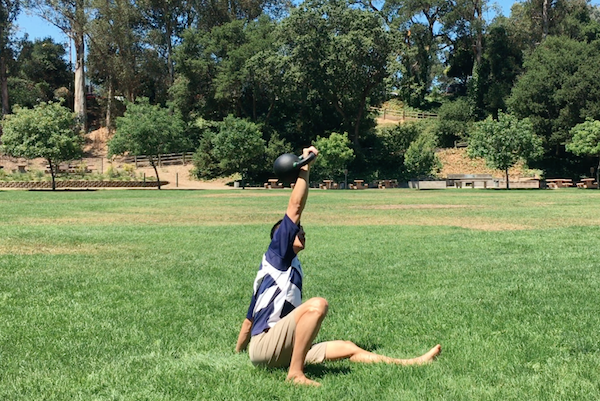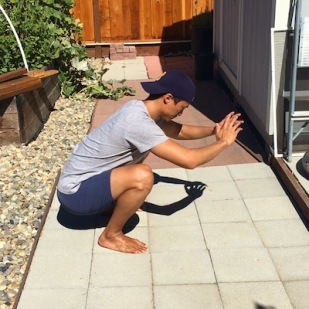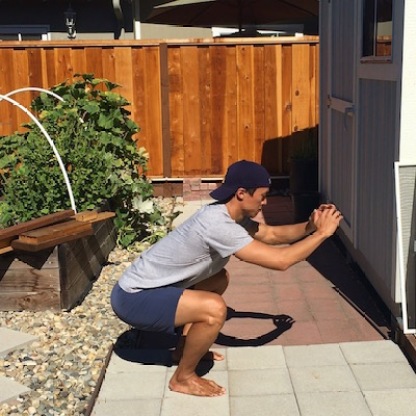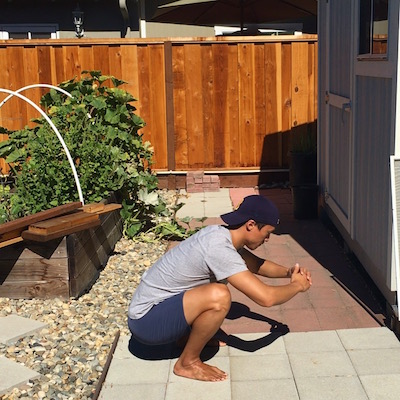Once again the mornings are warmer, and the ground does not freeze my feet. My breath no longer shows white in the dark. The sun climbs out from over the horizon quicker than it did a week ago, and every new day its aura soaks into the black sky a little bit earlier.
It wasn’t as cold as the previous year, though. The spring may prove to be a warm one, and I wouldn’t be surprised if the summer were to be hotter than those of recent memory.
It is raining again, and the rain will continue through the next few weeks before the earth grows hot. Two days ago, the rain sprinkled down lightly enough that I could swing the kettlebell without taking shelter between sets. The handle became a bit too wet to safely grip, though. I found a dry towel in a bag among the things outside that I haven’t yet stored away. I used the towel to wipe the handle down before each set, but eventually I left the towel on the handle and threw it aside just before the set. Some of the chalk on my hands washed away from droplets on the handle, but I was able to keep a firm enough grip on the bell.
Rain is good. It teaches you to not take dryness for granted. Stand in the rain as you train and you’ll learn that your grip on the bell isn’t as solid as you thought. A little slip is okay, but you need to play with the pull of the iron to keep your grip. Keep the handle in your fingers, or else your palm will blister and tear.
Rain will also teach you about your grip on the ground, with your feet. In the rain you’ll need to pay extra attention to keeping your big toes planted and pointed forward, still spreading the floor and not letting your feet swivel out. This has a lot to do with how you distribute your weight through the swing, and your hinging at the hips. You’ll learn to concentrate on driving the force down into the ground as you stand tall.
I think of the garden that my mom let me tend two years ago. Most of the vegetables I planted by seed are gone, brown caked rectangles of dirt where they once sprouted green and fresh. The collards alone survive the negligence of the past years, new stems ever pushing through the earth, mindless of heat or cold or rain or none. Unkept, the stalks will thicken to the size of a child’s wrist, scaly and strong, leaves massive.
Together with the earth, mankind turns in seasons, as man is one with the earth and not separate from her nature. As with a vegetable stalk that becomes tough, the mind becomes calloused and set in its ways, until there is little use left. It is time to cut the plant at its base, leaving the roots in the soil, and allowing the overgrown stalk and leaves to dissolve back into the earth, to become fodder for new growth. Nothing is lost, and everything dead is put to use again by the universe.
Do this with your thinking, with physical training, with social relations. Let the dead shell drop about you so that you can change. There is a point where the things that served you well, the skills and strengths and patterns you employed, may restrict movement. Do not be afraid to cut back into the armor to develop a stronger, more flexible, more resilient, more reasonable suit.
When men in our society train to increase strength, particularly with use of the barbell for absolute strength, they tend to go too far. It is human nature to become excited about one’s initial gain in physical power. A man often finds trouble once the regular increases in his training weight are not so easy to lift. He feels fear that he is not as good as he was in the beginning, when he could surpass himself and beat his own weakness. Most men quit, afraid of hurting themselves. Everyone else continues, stupidly. Rather than determine the level of strength that is necessary for survival and the degree of fitness sufficient for his duties in this life, the stubborn man continues to try to lift more weight. He pushes on, ignoring the pain in his joints, the diminishing abilities to move freely, and the unnecessary burden of nutrition and sleep to sustain the exercise.
Few take the time to slow down and think about the plateau they have reached before pushing themselves too far. This kind of man, whether it be long after many trials of stupidity, or a brilliant first encounter, realizes that his strength does improve in a linear progression. He also does not measure, nor does he care too much about, the numerical value of the weight he can lift. What’s important is how he moves the load.
Women generally know the futility of stubborn training. When a strong woman trains her strength according to her own sense, she tends not to push beyond a reasonable level of difficulty. She rarely injures herself or trains to a degree that inhibits normal movement. And yet she often becomes stronger than many men. Men should learn from strong women how to train strength.
What a great time it is to explore our strength. It takes strength to maintain calm, and how vital it is to remain calm when it is easier to let your fear take hold of you. Wake up, brilliant men and women! Continue to develop your strength, improve your diet, and clear your mind of unwanted thoughts, a little every day. If you find your season changing, shed your old skin and let yourself grow anew. Do it aggresively.
Do not let anyone else control your body, or your movements, or your mind, or your heart. Breathe freely, and act according to your principles. If you are young and strong, encourage those around you who are old or weak. Smile even if you are afraid. Do not let their fear seep into your mind, and gently assure them that all is well and promote good health and courageous living. Who else will do this, if not you?
Remember that each of us can choose how to behave. Be calm. Be brave. Treat your fellow man with dignity and respect. Create peace and solidarity within your family and let that be shared with the rest of your community. Do not give furtive looks at others as you pass them in the street. Don’t listen to too much news. Respect authority but don’t lose your mind in whatever you do.
Live powerfully,
Steve
























